Portrait photography is a fun and challenging assignment; you must understand and master the techniques in order to create stunning portraits.
A beautiful portrait image requires a lot of work. You must select the appropriate camera and lens. If you’re shooting with natural light, you’ll need to choose the right light and the right time of day.
You can use portrait photography techniques whether you are a wedding photographer, a corporate headshot specialist, or even a newborn photographer.
Equipment: Camera, Lenses, and Other Recommended Tools
Which Camera Should You Choose?
What camera and lens to use is the one question that every aspiring portrait photographer wants to be answered. There is no hard and fast rule that says you must shoot with a full-frame camera, though full-frame cameras have some undeniable advantages.
Any camera will suffice as long as you can shoot with a variety of lenses.
About Crop Factor
A full-frame lens will give you a slightly tighter composition with crop cameras. This allows you to get closer to your subjects even when using a medium tele lens, such as the 24 – 70mm wide zoom, which becomes the 35mm equivalent of a 36 – 105mm (1.5x Nikon) on an APS-C camera.
The best lenses allow you to change the perspective and, as a result, the background compression at will. As a result, zoom lenses are the best. However, there is no reason to dismiss prime lenses entirely.
If you are a beginner, start with a zoom lens. You can switch to a prime lens once you’ve figured out what you’re doing and what you’re shooting. Choose something like the 70-200mm f/2.8 or 18-200mm (preferable for its superior optical quality), which will provide you with enough focal length coverage to zoom in and out depending on the composition and effect that you require. Also, because it is a fast lens with a constant aperture, you can capture a lot of light in most situations.
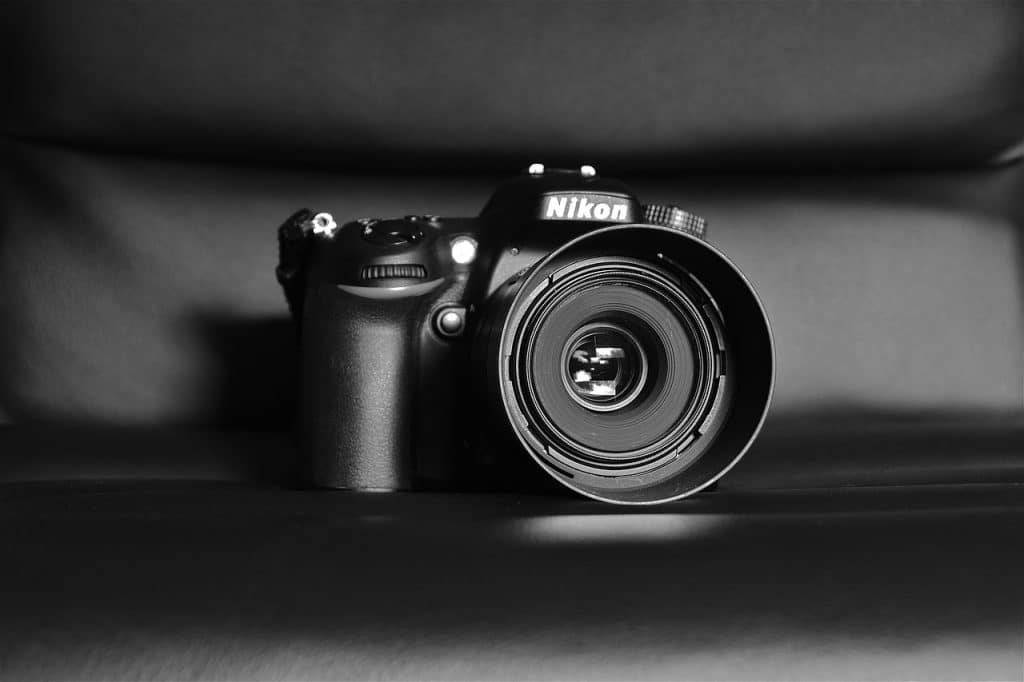
Keep a 24-70mm lens on hand for when you want to shoot in a wide-angle perspective, such as when shooting against a beautiful sunset, a majestic hallway, a lighthouse, or other background elements.
You’d also need a lens that’s sharp even when stopped down to f/11 or lower. After f/11, most cheap lenses suffer from lens diffraction, so avoid them.
The lens used will be determined by the shot. If you want to shoot a tight crop, you must use a lens that allows you to do so. On a full-frame camera, a lens like the 70-200mm should suffice. This is an excellent all-purpose lens. It is useful not only for portrait photography but also for a variety of other genres. The only issue is the price.
When compared to zoom lenses, prime lenses are optically superior. In general, they are less expensive than their zoom counterparts. So, if you’re on a tight budget, something like the 85mm f/1.8 is a fantastic lens to work with.
Other recommended tools
A CTO (Color Temperature Orange) gel, a hand-held light meter, and a color-checker passport are also recommended for white balance adjustment, especially when shooting in changing light conditions.
Recommended Camera Settings for Portrait Photography
When shooting outside, the camera settings will begin with an estimate of the ambient exposure. Check for ambient exposure and reduce it by about 1/3rd or 2/3rd stop. It is important to note here that the aperture, and thus the depth of field of your image, should be the first setting to be adjusted.
Keep your camera on aperture priority mode
Maintain your camera in aperture priority mode so that the shutter speed is selected automatically by the camera. To adjust the exposure, use exposure compensation (1/3rd or 2/3rd as explained). Fire the strobe, which should be set to an output that is at least one-third stop higher than the ambient exposure.
Use Auto ISO when needed
ISO is probably one aspect that few people pay much attention to. They usually keep the ISO as low as possible. 80, 100, or 200, depending on your camera’s capabilities. Some cameras have a feature called Auto ISO.
This allows you to manually set your aperture and shutter speed and then have the ISO number auto-adjust based on the available light. As a result, if the light is too dim, the camera will automatically increase the ISO to compensate.
Usually, when shooting outdoors in reasonable lighting conditions, you will never need to use Auto ISO. It only comes into the play when the light is very poor and you are shooting without external light.
Note: If you want to make some adjustments to the photo just let me know. I can do it for you at a very low cost. You can hire me to edit your photos.
Lighting for Indoor and Outdoor Portrait Photography
Using Natural Light Indoors
Natural light is an excellent way to capture stunning images. It is effective nearly 75% of the time. However, natural light, particularly direct sunlight, can be difficult to manage. A large window that receives a lot of natural light, preferably in direct sunlight, would be the preferred option.
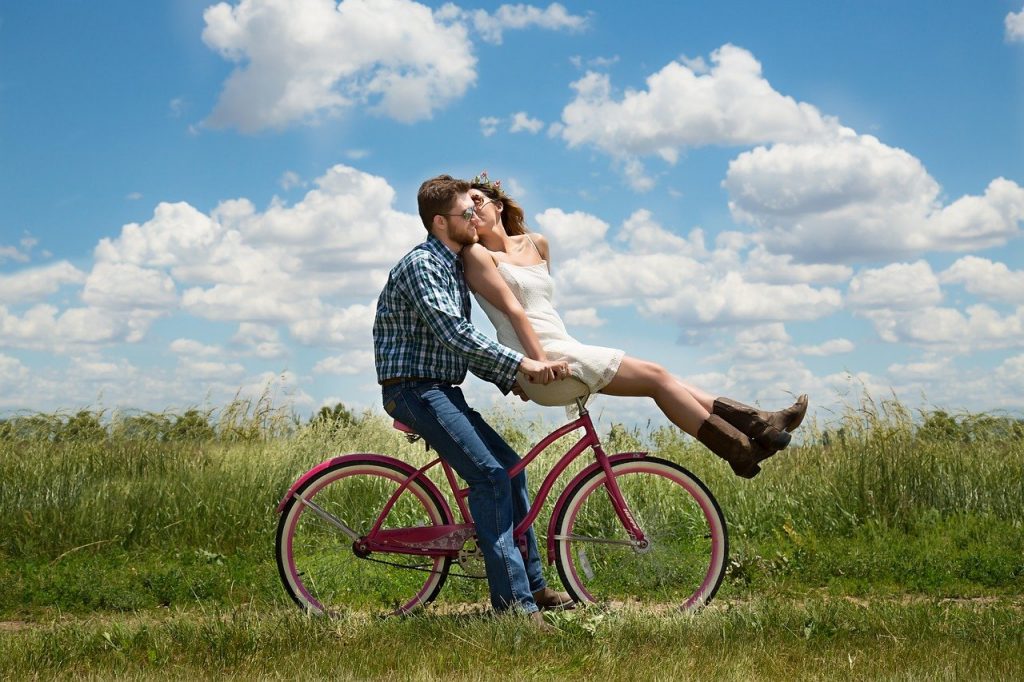
Use a diffuser when the light is too harsh
But what if the light coming in through the window is too harsh? The best way to deal with this is to use a fabric or diffusion material. The diffusion material softens the quality of the light, allowing you to create more flattering portraits than you would otherwise be able to.
Using Natural Light Outdoors
Shoot on an overcast day
Similarly, when shooting outside, choose an overcast day. It’s not an f/2.4 doomsday overcast, but more of an f/5.6-ish overcast day. When you book a pre-wedding session, however, it is impossible to predict what the day will be like three months later.
Choose the golden hour, about an hour before sunset
So, what do you do when it’s extremely bright on the day of the shoot? Choose the golden hour, which is about an hour before sunset (depending on the latitude and the season). The light at golden hour is softer and more flattering than midday sunlight.
Create artificial shadows
But what if the only time you can shoot is in the middle of the day? How do you deal with it? One solution is to cast artificial shadows. The solution is anything that provides a solid umbra, such as trees, walls, porticos, and even tall buildings. If you can’t find anything that produces a solid shadow, use the diffusing material described above. A piece of white cloth would work well.
Always balance the exposure for the face and the background
One thing to remember when shooting outdoors is to always balance the exposure for the face and the background. If you want to include the background in your shot, you’ll need two exposures: one for the background and one for the subject’s face. If the background is unimportant, use a wide-open aperture to completely blur it out, with or without the assistance of an external light source.
How should this be done? The first step is to set up a meter for the background. This way, you can properly expose for it. The next step is to add just enough external light to ensure that the exposure for the face is equal to that of the background. The ambient exposure for the background should ideally be one-third to two-thirds of a stop darker than the exposure for the face.
Using Strobes
Blue hour is another fantastic time to shoot. Blue hour is the brief window of 30 to 45 minutes that follows the golden hour but before the sky completely darkens. It works because the contrast between a well-lit couple and the dark blue to
black sky is stunning at this time of day. Strobes aid in getting good exposure for a subject/couple against a strikingly contrasty blue background.
Using Light Modifiers, And Using Small Flash Units
Another great time to shoot is during blue hour. Blue hour is the brief period of time that follows the golden hour but before the sky completely darkens. It works because the contrast between a well-lit couple and the dark blue to the black sky at this time of day is stunning. Strobes help to get good exposure for a subject/couple against a strikingly contrasty blue background.
Balancing exposure with Softboxes
The technique for shooting with softboxes is very similar to what has already been explained above. You must ensure that the exposure is one-third to two-thirds of a stop higher than the background. There are literally millions of different lighting scenarios that can be used in this situation. Broad lighting, butterfly lighting, Rembrandt lighting, and clamshell lighting are examples of these.
Portrait Photography Tips and Techniques: How to Create Stunning Imagery
Composition – A Word On Leading Lines
Compositional advice has been provided in bits and pieces in the preceding paragraphs, but here are some more specific suggestions. Who doesn’t enjoy a good lead line? Great photographers seek them out whenever possible. So, why should they be avoided when photographing a couple?
If you’re photographing a wedding, look for a wall, preferably a white wall or fence, to use as a leading line. You can also use a path, either graveled or paved, to lead the viewer into the shot and the couple.
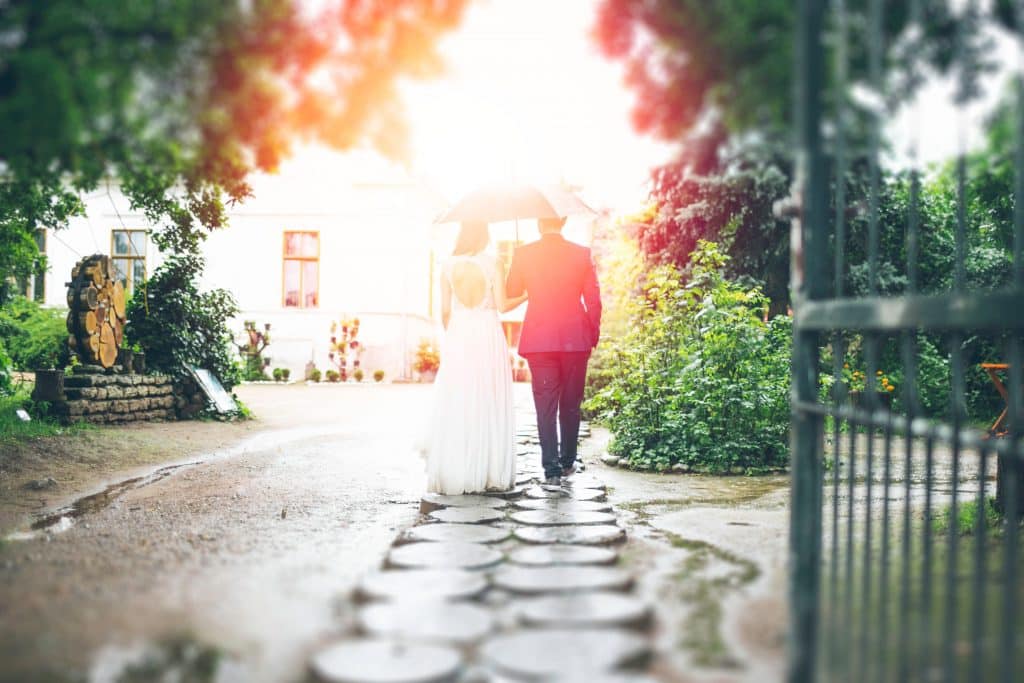
Background
Whether or not you use the background in the composition will be determined by whether or not it adds anything to the photograph. If you have a wide-open prime lens, such as the 85mm f/1.8, you might be tempted to shoot at f/1.8, obliterating everything in front and behind the focusing point.
However, you can get a larger depth of field by using a 24-70mm lens at something like 40-ish mm and stopping down the aperture. Everything is dependent on how interesting the rest of the scene is.
If you’re shooting at the peak of the golden hour, around the time when the blue hour begins to appear, you might want to use a wide-angle lens with a shallow depth of field (use a small aperture). The sky is blue, and the setting sun is still holding up one corner with bright yellow, red, and orange hues. You can experiment with these colours by exposing for the background and lighting the subjects with a strobe. A large depth of field that includes the background becomes necessary.
Shooting Angles
When photographing a woman, raise your camera slightly so that she is looking up rather than down. This has a number of advantages. First, her jawline is tighter and firmer, with little chance of a double chin. Second, her body appears thinner and more proportionate, which is always a plus.
The issue is that when shooting a couple of shots, you must photograph both the man and the woman together. That means two postures that should be ideal for each other. In addition, there is one camera angle that would complement both the man and the woman. There are several parameters that tend to go into deciding what camera angle to shoot from when you are photographing a couple.
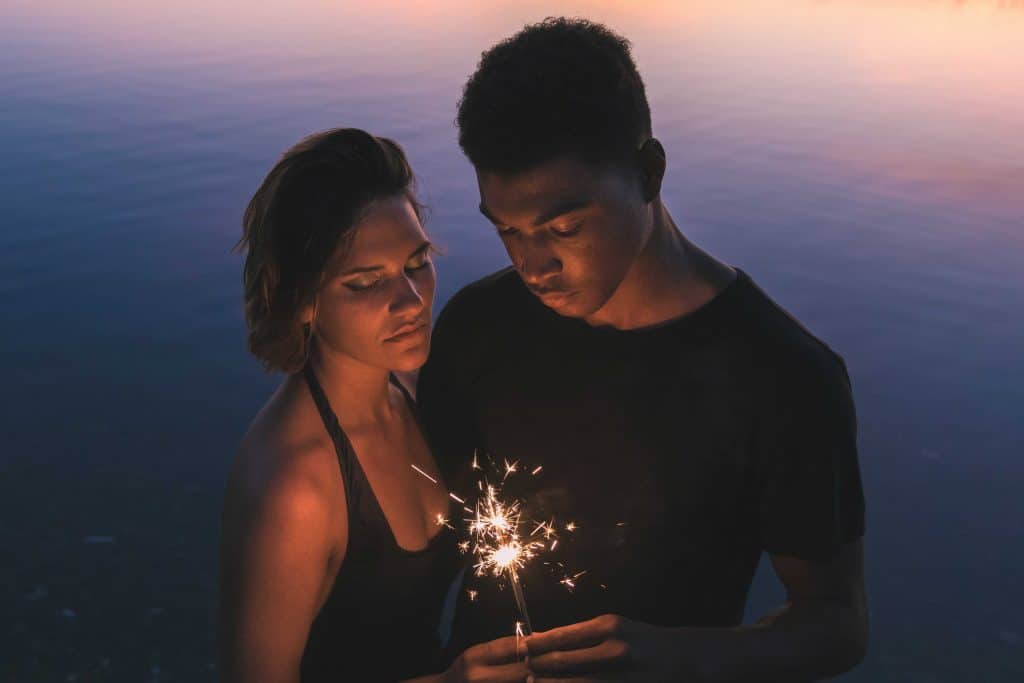
If the woman is significantly shorter than the man, shoot from a slightly downward angle. Having said that, you can play around with the angle, shooting from a lower or higher angle with different backgrounds and focal lengths to see what works. Using a wide-zoom lens and zooming in from a distance is one of the tricks.
Portrait Photography Poses
Did you know that your couple’s posture can make or break an image? For example, most people have no idea what to do with their hands. When a couple is shy or uncomfortable to begin with, things tend to go south. So the first step is to acclimate them and instill confidence in them.
Use the man as your pole position
Make sure you have their postures correct once you see that they have the confidence to face the camera. Men are frequently surprisingly calmer and more self-assured than their female counterparts. You can use him as a pole position. Request that he stand firm with his hands in his pockets and only his thumbs protruding. The traditional macho stance. If there is a back railing or a wall, have him raise one foot and support it on the wall/railing behind him.
The woman is capable of holding her man’s hand. The woman on the left and the man on the right are popular subjects for photographers. This may appear to be the polar opposite of the Yin and Yang concept. You are free to experiment with different poses to see what works best for you. Whatever you do, don’t be afraid to try new things.
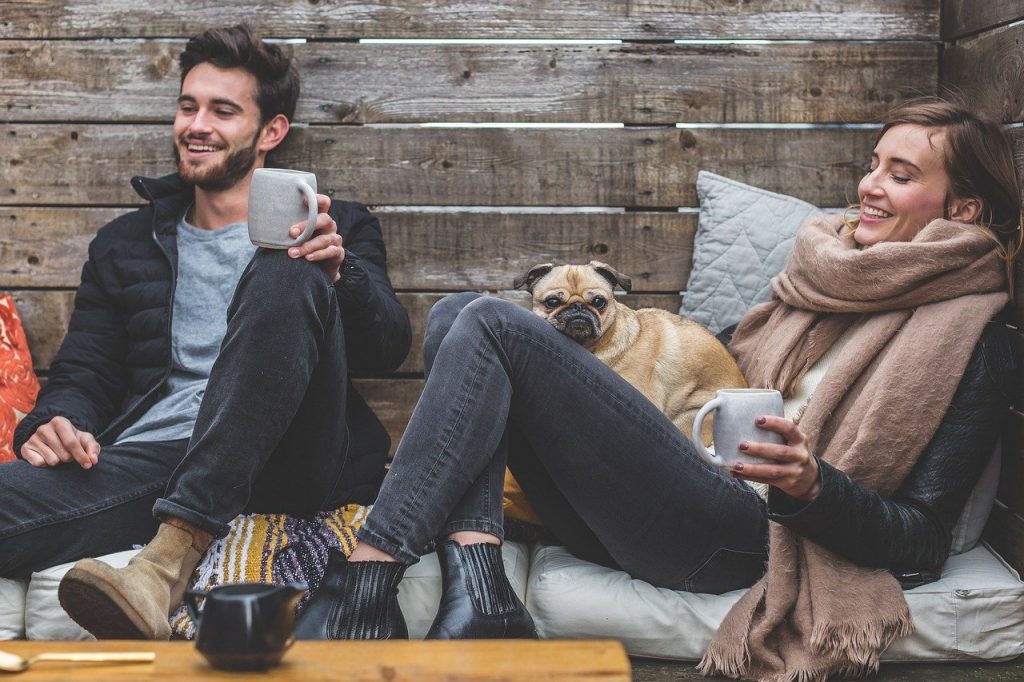
Try using the off-camera look
You could also experiment with the off-camera look. Begin with the classic look, which is a natural result of the first paragraph’s tip. “How did you feel when you first saw each other?” inquire the couple. When they’re looking at each other and smiling, reminiscing about the moment, that’s your cue to take the shot.
In terms of postures, you could also try the woman leaning on the man with her right hand over his chest and her head leaning into his. This is usually a good place to begin.
The Secrets to Put the Subject at Ease
Physician Heal Thyself
You are not just a photographer with a camera taking pictures of a couple. You are their source of assurance.
Most of the time, a couple is conflicted about having their picture taken. The woman is almost always overly self-conscious and concerned about the outcome. So, even if you’re a nervous wreck, even if it’s your first couple of session, don’t show it. A nervous photographer is the last thing anyone needs at a couple of photoshoots.
Compliment the Couple
If you notice that your couple is nervous, remove the camera and tell them that they look great together. Even if you know how long they’ve been married (or if you know each other if it’s a pre-wedding shoot), make it a point to ask. Always compliment them after they’ve responded. It usually takes the focus away from the shoot and introduces a moment of reflectance. For a brief moment, their attention is drawn away from the photoshoot and toward their relationship.
Find The Right Balance
It’s always a fine line between micromanaging and letting the couple take your cues and then do something on their own. According to my experience, the first few minutes are the most difficult. ‘Breaking the ice’ necessitates some extra effort.
Things become much easier after the first few minutes are over.
Smile
You, believe it or not, set the tone for a portrait shoot (or a couple of shoots for that matter).
So, if you’re smiling, cheerful, and joyful, things will be a lot easier to handle. A cheerful demeanor and a joyous demeanor at work become contagious. When your couple sees a friendly face in front of them, they are more likely to feel at ease.
Crack A Joke
Keep some jokes on hand and use them when the occasion arises. It helps to keep things light. Any portrait photographer who works for a living must have exceptional interpersonal skills.
Insider Tips from the Expert
The most difficult situation we’ve had to deal with is mixed lighting at Indian weddings. If you’ve ever been to an Indian wedding, you’ll know that it’s always a big, elaborate affair, with friends and family gathering and often staying together for a couple of days at a resort until the formalities are finished. Receptions are always held in the evening at a venue, which is always decked out with artificial lights.
The problem with these artificial lights is that they are never consistent; meaning, they are of different types and styles. Plus, they are never daylight-balanced. The challenge is to overpower these artificial lights so that you can create a decent one-color cast that you can adjust in post-processing later on. The solution is to use a strong external light source.
Another issue we’ve encountered is applying a specific effect to a shot, such as when shooting a pre-wedding or engagement shoot and needing to achieve the golden hour effect. The traditional approach is to shoot during the golden hour, but what if we shoot early in the afternoon?
We typically employ a CTO gel in conjunction with a powerful strobe. The CTO gel gives the light fired by the strobe a strong orange color cast. This simulates the light of the sun during the golden hour.
The Final Touch: Printing the Photos
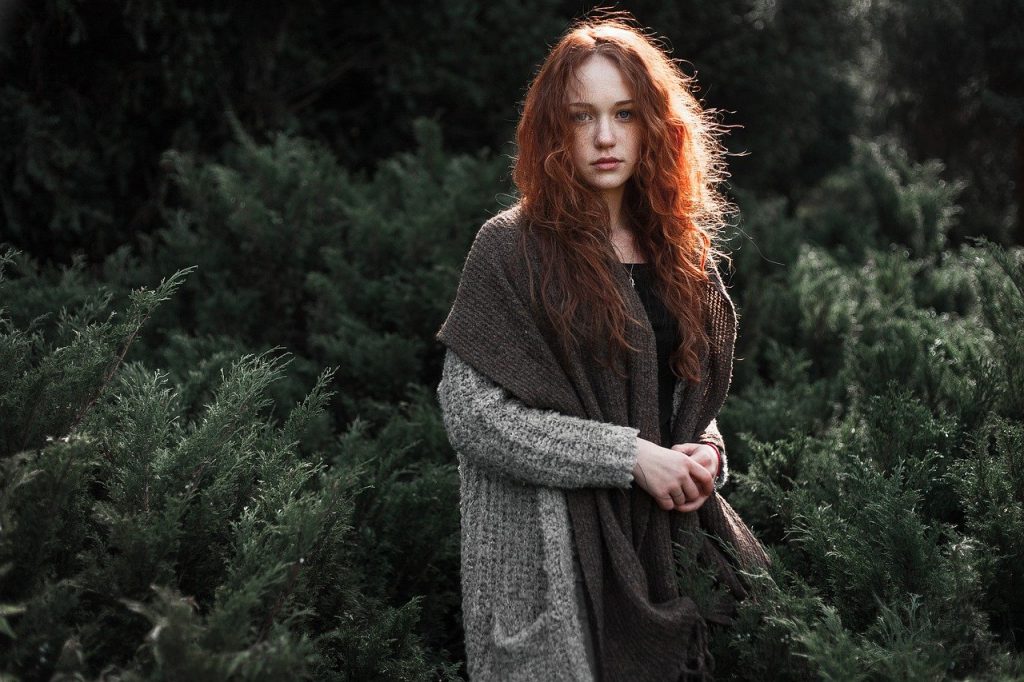
When you’ve finished shooting and editing the images, present them to your client in a beautiful photo album. There is a significant difference between seeing photos on a screen and seeing them in person, and having the images neatly arranged and printed on high-quality materials will undoubtedly enhance the overall experience.
Our Pro Plan service is intended to assist photographers in providing the best possible experience for their clients. You can create bespoke albums with your own branding and design using a premium range of handcrafted photo albums, resulting in personalized albums with a high-end look.
If you have any questions about this service, please do not hesitate to contact us!
Note: If you want to make some adjustments to the photo just let me know. I can do it for you at a very low cost. You can hire me to edit your photos.
latest post
- What is Midjourney
 Discover the capabilities of Midjourney AI, learn how to effectively utilize the platform, and explore the advantages and disadvantages of the Midjourney AI image generator across its different pricing options.
Discover the capabilities of Midjourney AI, learn how to effectively utilize the platform, and explore the advantages and disadvantages of the Midjourney AI image generator across its different pricing options. - Brand identity elements
 In the vast marketing universe, imagery is pivotal in establishing and nurturing a brand’s identity. A brand’s visual choices are not merely aesthetic decisions but strategic moves that can significantly influence perception and performance. This Picfixs article explores the intricacies of selecting imagery that complements and enhances a brand’s essence, ensuring it resonates with the… Read more: Brand identity elements
In the vast marketing universe, imagery is pivotal in establishing and nurturing a brand’s identity. A brand’s visual choices are not merely aesthetic decisions but strategic moves that can significantly influence perception and performance. This Picfixs article explores the intricacies of selecting imagery that complements and enhances a brand’s essence, ensuring it resonates with the… Read more: Brand identity elements - 100 Best Mountain Captions and Mountain Quotes for Instagram
 Ready to scale new social media heights? Look no further than this treasure trove of 100 exhilarating captions and quotes, handpicked for your Instagram mountain posts!
Ready to scale new social media heights? Look no further than this treasure trove of 100 exhilarating captions and quotes, handpicked for your Instagram mountain posts! - Symmetry in Photography: A Creative Approach with Examples
 Delve into the enchanting realm of symmetry in photography as we showcase mesmerizing examples on our website. Experience the allure of perfectly mirrored images!
Delve into the enchanting realm of symmetry in photography as we showcase mesmerizing examples on our website. Experience the allure of perfectly mirrored images! - 11 Quarantine Photoshoot Ideas to Try at Home for Amazing Photos
 Looking for unique photoshoot ideas during quarantine? Explore the 11 creative suggestions that will help you capture unforgettable moments at home.
Looking for unique photoshoot ideas during quarantine? Explore the 11 creative suggestions that will help you capture unforgettable moments at home.

